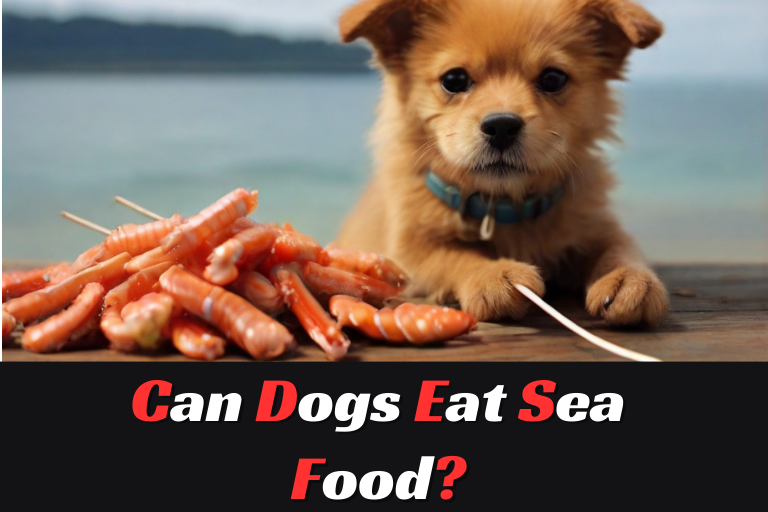Can Dogs Eat Seafood Sticks?
Let’s explore Can Dogs Eat Seafood Sticks? In recent years, the pet food market has expanded to include a wide variety of treats, including seafood sticks.
As pet owners, we often find ourselves questioning whether certain human foods are safe for our furry companions.
Seafood sticks, with their enticing aroma and convenient packaging, may seem like a tempting snack to share with your dog.
However, before offering your canine companion a taste, it’s crucial to consider whether seafood sticks are suitable for dogs and what potential risks they may pose.
1. Introduction

Seafood sticks, also known as imitation crab sticks or crab-flavored seafood sticks, are a popular human snack made from minced fish, typically surimi, starch, and various flavorings.
These sticks are often used in salads, sushi, sandwiches, and as standalone snacks due to their convenient packaging and affordable price point.
2. What Are Seafood Sticks?
Seafood sticks are made by processing fish, typically white fish such as pollock or cod, into a paste known as surimi.
This paste is then mixed with starch, flavorings, and colorants to mimic the taste, texture, and appearance of crab meat. The resulting mixture is shaped into sticks and cooked before being packaged and sold.
3. Nutritional Value of Seafood Sticks

Seafood sticks are relatively low in calories and fat, making them a popular choice for individuals looking for a light snack. However, they are also high in sodium and may contain additives and preservatives to enhance flavor and prolong shelf life.
4. Can Dogs Eat Seafood Sticks?
While dogs can technically eat seafood sticks, they are not an ideal treat for several reasons.

4.1 Potential Risks
Seafood sticks are often high in sodium, which can be harmful to dogs in large quantities. Excessive sodium intake can lead to dehydration, electrolyte imbalances, and even sodium ion poisoning, especially in smaller breeds or dogs with underlying health conditions.
Furthermore, seafood sticks may contain additives, flavorings, and colorants that are not suitable for dogs and may cause gastrointestinal upset or allergic reactions.
Additionally, the shape and texture of seafood sticks pose a choking hazard, particularly for dogs who are prone to gulping their food without chewing properly.
Given these potential risks, it’s best to avoid feeding seafood sticks to your dog and opt for safer, dog-friendly alternatives instead.
5. Safe Alternatives to Seafood Sticks

If you’re looking for safe and nutritious treats to offer your dog, consider the following alternatives:
- Cooked Fish: Cooked fish, such as salmon, tuna, or cod, can be a healthy and delicious treat for dogs. Be sure to remove any bones and seasonings before serving.
- Fresh Fruits and Vegetables: Many fruits and vegetables, such as apples, carrots, and blueberries, are safe for dogs to eat and provide essential vitamins and minerals.
- Commercial Dog Treats: There are plenty of dog-friendly treats available on the market that are specifically formulated to meet your pet’s nutritional needs.
6. Tips for Introducing New Foods to Your Dog
When introducing new foods to your dog’s diet, it’s essential to do so gradually and in moderation.
Start by offering small amounts of the new food and monitor your dog for any signs of digestive upset or allergic reactions.
If your dog tolerates the new food well, you can gradually increase the portion size over time.
7. Conclusion

In conclusion, while seafood sticks may seem like a tempting snack for your dog, they are not the safest or healthiest option.
Due to their high sodium content, potential additives, and choking hazard, it’s best to avoid feeding seafood sticks to your canine companion.
Instead, opt for safer alternatives that are specifically formulated for dogs and consult with your veterinarian if you have any concerns about your dog’s diet or nutrition.
8. FAQs
Here are some common questions pet owners may have regarding Can Dogs Eat Seafood Sticks:
8.1 Can dogs have a small bite of seafood stick occasionally?
- While a small taste may not be harmful to most dogs, it’s best to avoid giving them seafood sticks due to their high sodium content and potential choking hazard.
8.2 Are there any benefits to feeding seafood sticks to dogs?
- Seafood sticks do not offer significant nutritional benefits to dogs and may pose more risks than rewards. It’s advisable to choose healthier, dog-friendly alternatives for your pet’s snacks.
8.3 What should I do if my dog accidentally eats a seafood stick?
- If your dog consumes a small amount of seafood stick, monitor them for any signs of gastrointestinal upset or distress. Contact your veterinarian if you notice any unusual symptoms or if your dog ingests a large quantity.
8.4 Can seafood sticks be toxic to dogs?
- While seafood sticks themselves are not inherently toxic, the additives, flavorings, and high sodium content in some varieties can be harmful to dogs, especially if consumed in large amounts or on a regular basis.
8.5 What are some safe seafood options for dogs?
- If you’d like to offer your dog seafood as a treat, opt for cooked, unseasoned fish such as salmon, mackerel, or cod. Be sure to remove any bones and avoid using sauces or seasonings that may be harmful to dogs.
In summary, while it may be tempting to share your favorite snacks with your furry friend, it’s essential to prioritize their health and well-being by choosing safe and nutritious treats that are specifically formulated for dogs.
Now that you’re equipped with the knowledge about the potential risks of feeding seafood sticks to dogs, you can make informed decisions about your pet’s diet and nutrition.
Remember, when in doubt, consult with your veterinarian to ensure you’re providing the best care for your canine companion.
Related Posts :
- Let’s Understand: Why Westies Are the Worst in 2024?
- Let’s Understand Why Schnauzers Are the Worst Dogs in 2024
- Let’s understand Is Pura Safe for Cats?

